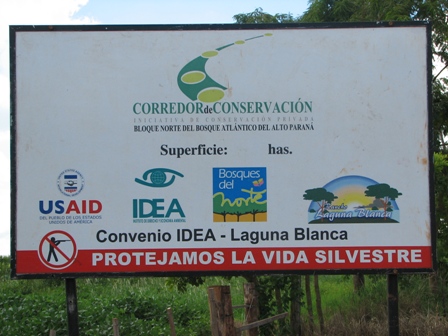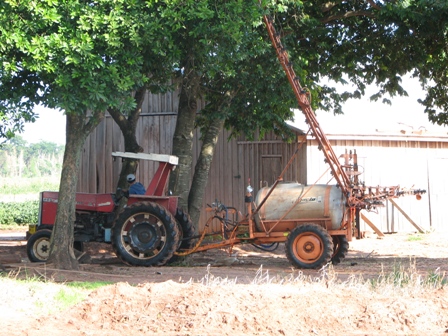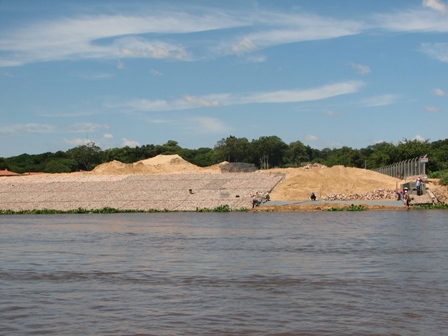Final Dispatch: Andrea and Jodie writing from the South American soy frontier
On the way back from visiting the threatened Yaguarete forest and the community of Tava Guarani, we happened upon a soy plantation called Laguna Blanca. It wasn’t hidden; in fact, a large billboard outside the plantation gate proudly advertised it, and called our attention with the words “Corredor de Conservación” (conservation corridor). Various NGO sponsors that in some way or another lend their assistance to the “project” were listed at the bottom. Among them was US AID–the U.S. government’s foreign aid institution.
We got out of the car in order to peak through the front gate and also to take a few pictures of the sign. We were interested in how this soy plantation, or what aspect of it, could be considered a conservation corridor. All of a sudden we realized that a huge sprayer with long arms on each side was maneuvering through the field, diffusing liquid white clouds of toxic chemicals into the air and on the crops. Within seconds of standing at the perimeter of the soy plantation, we smelled the strong fumes of the chemical that was being applied. No doubt, so did the family that lives directly across the small dirt road and whose children were running around the front of their house during the spraying.
Eventually, the driver of the sprayer made his way towards us across the soy field, and parked. When he climbed down off the machine, we were able to see that he was wearing only jeans and a t-shirt. He had absolutely no form of protection on–nothing to protect him from inhaling the toxic fumes, and nothing to protect his skin from coming in contact with the miniscule drops of spray that he was applying in all directions. He saw that a few people were standing at the fence looking in, and walked over to us. We talked for a few minutes and during our brief conversation, he provided us with two extremely critical pieces of information. One, he said that there is no requirement that he use any form of protection. Second, he told us that all the soy from this plantation is sold to the Cargill silo down the road in Santa Rosa. We thanked him for his time, and jumped back in the car. Our next destination: Cargill in Santa Rosa.
About 25 minutes after leaving Laguna Blanca soy plantation, we arrived at the entrance of the Cargill silo. Although it was a Saturday, we hoped to find somebody to speak with. I knocked on the door of the small office and was invited in. I introduced myself as working for RAN on a campaign related to agribusiness. Mr.Cleiner Maeda, who is involved in commercialization at that silo was very open to having a conversation and answering all of my questions. He was incredibly candid, perhaps more so than the top execs at Cargill H.Q. in Minneapolis may have appreciated. During my brief meeting, I learned that the Cargill silo purchases soy from whoever comes to sell it to them. They have no requirements with respect to the plantations they do business with, but only check to ensure that the soybeans meet an international quality standard.
Mr. Maeda wasn’t surprised to hear that a worker on a plantation that sells to Cargill was completely unprotected while applying toxic chemicals. He didn’t have any response other than to say that the use of agrochemicals in soy production is rampant and will probably cause major environmental devastation in the long run. He stated numerous other facts like, soy production is causing deforestation in Paraguay, and it benefits large landowners but is not helping the country’s small farmers whatsoever. But, this Cargill rep was also eager to tell me that the company is doing something to remedy the problem of deforestation. They are buying 800 hectares of land in the state of Alto Paraná, so that they can reforest it with Eucalyptus. Before I left, he had one last thing to share with me. Three enormous boxes beside his desk were filled with Cargill school kits for children in the nearby communities. Each kit comes with several notebooks, pads of paper, a pack of pencils, and is nicely wrapped in a bag. Every item has the Cargill logo on it. In a country like Paraguay, where the State is often non-existent and provides few social services, Cargill’s name brand benefits by providing desperately needed items like school kits, regardless of the impunity with which they operate on the ground.
Back in Asuncion a couple of days later, we were preparing for another meeting. Two Cargill executives based in Paraguay were interested in meeting with us, as well us giving us a boat tour of their planned port on the Rio Paraguay. Jodie and I met them at their office in the Citi building. After passing through a couple of light security checks (exchanging our ID cards for Cargill badges), and getting buzzed into their office, we spent less than one minute in the lobby before being cordially greeted by Fernando Acosta, the general manager for Cargill in Paraguay and Bolivia, and Francisco Solano, the project manger for the new port. The four of us sat comfortably around a table fit for 15 or 20. After brief introductions, Francisco directed our attention to the screen at the end of the room and presented a power point presentation on their port project. The presentation included scope of project, social impact, technical assumptions, products to be processed, mitigation measures, and a history of the licensing process.
The biggest threat posed by this new port is the contamination of the entire drinking supply for the 1 million inhabitants of the capital city of Asuncion. And nothing in this presentation provided persuasive evidence to convince us that building a port just 500 meters upstream from the public utility water intake could possibly be safe. In fact, their principle rationale for the new Cargill port not posing a threat is that there are already several small industrial operations upstream from the same water utility. Fernando was proudest to share that through Cargill’s community cares program, they are improving an elementary school, building fire and police stations, and parks in the impoverished community that abuts the port. Albeit a touching gesture, none of these measures address the contamination of the city’s water.
The second half of our meeting took place on a yacht on the Rio Paraguay. We arrived at a dock to board a yacht which would take us on a tour of the planned port, the water utility, as well as other industries that operate in the area. In actuality, the tour amounted to very little beyond the relief of a cool breeze in 90 degree weather. We saw about six workers reinforcing the bank of the river in preparation for construction of the port. We saw the water utility, which indeed was incredibly close to the Cargill site. And, Fernando and Francisco were adamant about pointing out the other industries already operating in the vicinity. Their argument recalled the common childhood refrain, “They’re doing it, so why can’t I?”
On the night of our meeting , we participated in a public event and press conference with partners from Paraguay and Brazil to discuss international movements against Cargill. Even though the Cargill port was approved at the end of December 2007, these partners in Paraguay along with others continue to fight against it. Our consent cannot be won by a yacht ride. There are plans to take this case to the high court in Paraguay in order to revoke the license for construction. RAN will support the struggle and stand by our partners until the end.



